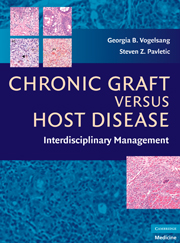Book contents
- Frontmatter
- Contents
- List of Contributors
- Preface
- PART I GENERAL PRINCIPLES
- PART II CLINICAL MANAGEMENT
- PART III ORGAN SITE OR SYSTEM-SPECIFIC MANIFESTATIONS
- PART IV SPECIAL CONSIDERATIONS IN CHRONIC GVHD
- 31 Design of Clinical Trials Testing Treatment for Chronic Graft versus Host Disease
- 32 Spectrum of Chronic Graft versus Host Disease in Unique Clinical Situations: The Role of Stem-Cell Source Including Cord Blood Stem Cells, Reduced-Intensity Conditioning, and Donor Leukocyte Infusions
- 33 Pediatric Chronic Graft versus Host Disease
- 34 Principles of Interdisciplinary Practice in the Care of Patients with Chronic Graft versus Host Disease
- 35 Patient Advocacy, Education and Psychosocial Support
- 36 Future Directions
- Index
- Plate section
32 - Spectrum of Chronic Graft versus Host Disease in Unique Clinical Situations: The Role of Stem-Cell Source Including Cord Blood Stem Cells, Reduced-Intensity Conditioning, and Donor Leukocyte Infusions
from PART IV - SPECIAL CONSIDERATIONS IN CHRONIC GVHD
Published online by Cambridge University Press: 26 August 2009
- Frontmatter
- Contents
- List of Contributors
- Preface
- PART I GENERAL PRINCIPLES
- PART II CLINICAL MANAGEMENT
- PART III ORGAN SITE OR SYSTEM-SPECIFIC MANIFESTATIONS
- PART IV SPECIAL CONSIDERATIONS IN CHRONIC GVHD
- 31 Design of Clinical Trials Testing Treatment for Chronic Graft versus Host Disease
- 32 Spectrum of Chronic Graft versus Host Disease in Unique Clinical Situations: The Role of Stem-Cell Source Including Cord Blood Stem Cells, Reduced-Intensity Conditioning, and Donor Leukocyte Infusions
- 33 Pediatric Chronic Graft versus Host Disease
- 34 Principles of Interdisciplinary Practice in the Care of Patients with Chronic Graft versus Host Disease
- 35 Patient Advocacy, Education and Psychosocial Support
- 36 Future Directions
- Index
- Plate section
Summary
INTRODUCTION
Several risk factors were found to be associated with the incidence and severity of chronic graft versus host disease (cGVHD) after allogeneic stem-cell transplantation (allo-SCT). The most important factor is likely to be the development of significant acute GVHD; but other classical risk factors including older age, a female donor (especially to a male patient), or some diagnoses such as chronic myeloid leukemia (CML) or aplastic anemia, were also reported. Some unique clinical situations such as the use of mismatched or unrelated donors (URDs) may be also associated with a higher risk of cGVHD, likely because of an increased reactivity between donor immune effectors and host cells. In the last decade, exploring cGVHD has also gained in importance, as more transplant centers are increasingly using allogeneic granulocyte colony-stimulating factor (G-CSF)-mobilized peripheral blood stem cells (PBSC). The latter has been associated with an increased incidence of cGVHD in most studies of human leukocyte antigen (HLA)-matched sibling transplantation. More recently, the use of the so-called reduced intensity or nonmyeloablative conditioning (RIC) regimens with or without systematic donor leukocyte infusion (DLI) also showed that cGVHD is still a major limitation. Similarly, the natural history of cGVHD appears to be modified after cord blood transplantation, and will need to be closely monitored. The aim of this chapter is to address the clinical, biological, and therapeutic features of cGVHD in the specific context of the above-mentioned unique clinical situations.
- Type
- Chapter
- Information
- Chronic Graft Versus Host DiseaseInterdisciplinary Management, pp. 360 - 368Publisher: Cambridge University PressPrint publication year: 2009



